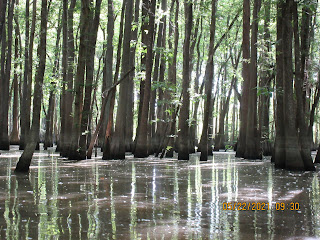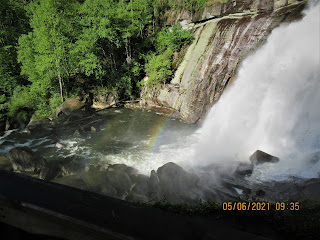The meter indicates we should have a nice day in Congaree National Park. It was a outstanding visit. Our guide for the day, John Cely, met us at the Harry Hampton Visitor Center early in the morning. All the employees and volunteers knew him and spoke with him. One of the rangers gave him a report on the previous night at the park. It is synchronous firefly time and the park is closed to only those with lottery slots after 4pm. Just 25 cars are permitted in the park. There is a designated trail to follow after dark. Everyone must use only low level red light as needed to walk. There were makeshift curtains at the parking lot to limit car light. From the report given by the ranger, it was a nice night with a number of international visitors in attendance.

I didn't know the credentials of John Cely beforehand. After a few minutes with him, it was apparent that he knew this place intimately and perhaps better than anyone else. His first visit was as a young sophomore at Clemson in 1967. He had read about the swamp and Harry Hampton's efforts to preserve it. He got in touch with Harry and got his initial tour. Ever since, he has been spending time here.

Francis Beidler bought the land in 1881. It was part of a 165,000 acre holding. Beidler did some timbering but changed his mind in 1915 and suspended logging. After his death, his family began logging again in the 1950s into the 1960s. It was Harry Hampton who led the charge to try to protect the area. The government did acquire a sizeable tract and it became a National Monument and later a National Park. The Beidlers were allowed to continue operating a fish and hunt club until the National Park was established. So, when John Cely first began exploring here, there was a road, now the Sims Trail, to a hunt camp on Cedar Creek. We saw the site of the camp. John said it was a first class place. The road, back then, was lined with magnificent Lobollies. Those trees succumbed to Pine Bark Beetles and are no longer there.

John is good at spotting snakes. This one is a water snake. He says people confuse it with the Cottonmouth because it has a triangular head. Apparently, some water snakes have that triangular head as well. He says the snake population has declined significantly due to the feral hogs that roam the park. Hogs eat them.
The trees are large here. It is their height that is really impressive. There are many state and national champions. Those titles change often as there are so many researchers measuring trees everywhere now. John states that the big trees here often lose the title to trees that are not in a forest. Forest trees grow tall to compete for canopy space but field trees grow fat. A champion is determined by height, girth and canopy spread. This puts forest trees at a disadvantage.
The Loblolly kids
We saw many Water Tupelos as we walked. There were some Bald Cypress. Then the other trees started making a presence - Red Mulberry, Cherrybark Oak, Persimmon, Hornbeam, Holly, Beech, Paw Paw, Overcup Oak, Green Ash, Swamp Chestnut, Sweetgum, Sycamore and a few more.
There was one area along the boardwalk that had lots of sunlight. These Forest Tint Caterpillars eat the leaves defoliating the trees. They do not eat the Cypress but make there cocoons on the Cypress leaves.

John's decades in the swamp and forest have given him a unique perspective on how things have changed here. Of course, ceasing logging operations and the eventual conservation of the land, had a profound effect. Then in September 1989 another profound change began to take place. Hurricane Hugo made landfall near Charleston and roared through this area on its way to the other Charleston, in West Virginia. Wind gusts of 90 mph, previously unheard of in this area, tore the tree tops out and blew others over. I traveled through this area a few days after Hugo and it looked like every pine in SC had been damaged. The hurricane opened up the canopy and things began to change. Undergrowth and thickets began to take over the ground. What was open and an easy walk through, became littered with obstacles. Invasives found a place to get a foothold. We saw Japanese Stiltgrass and Privat on our hike.
Indian Pink
John got a kick out of measuring trees and letting us guess the circumference. I think this one was 17.1 feet.
We stayed on the trail for most of the hike but John seemed to know exactly where to step off into the forest to find the next big tree. Our 4 hour tour came to a close. John asked what we were doing with 3 kayaks tied to the car. Suddenly, John suggests he guide us through the Sparkleberry Swamp on Saturday.

































































